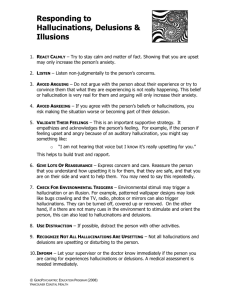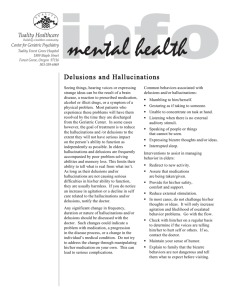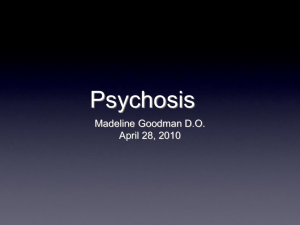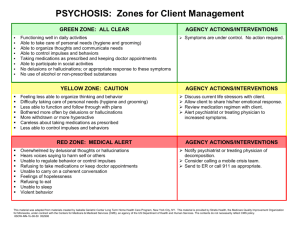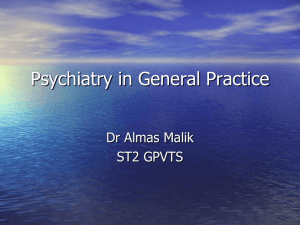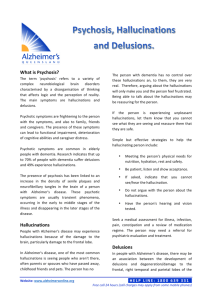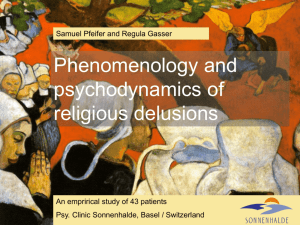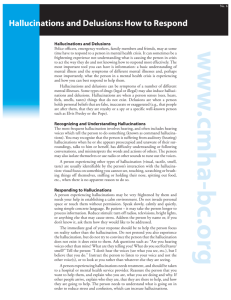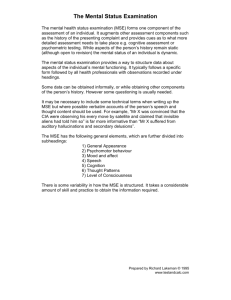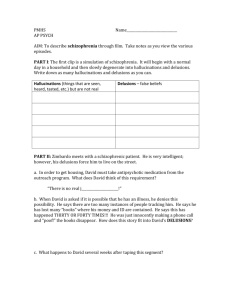Hallucinations and Delusions
advertisement
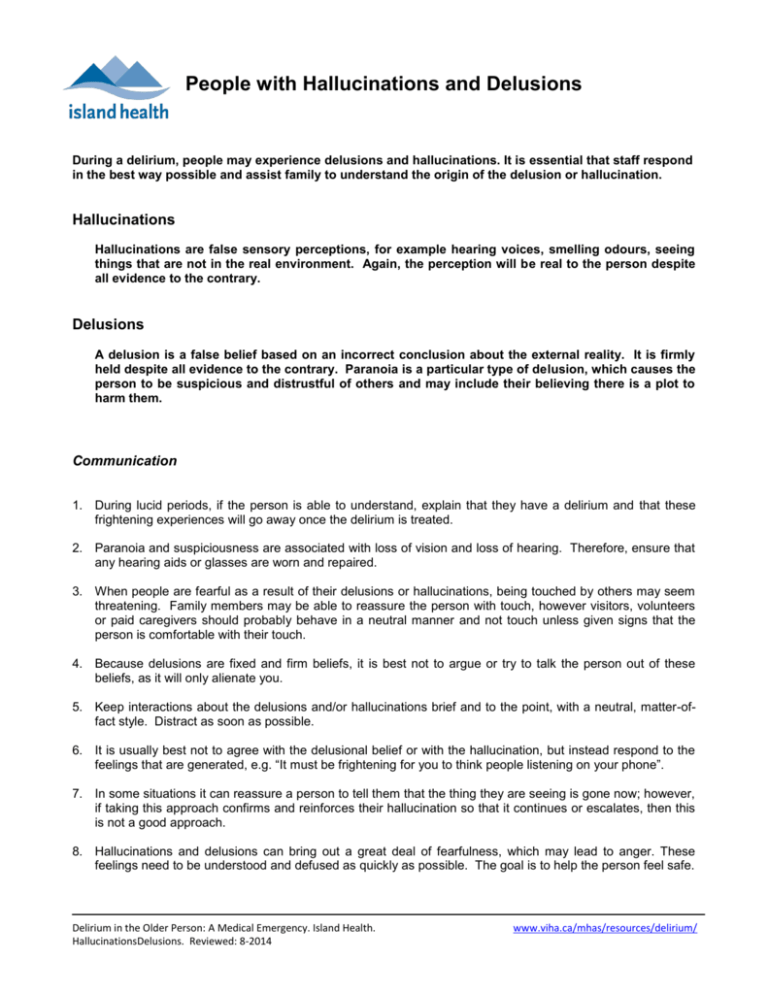
People with Hallucinations and Delusions During a delirium, people may experience delusions and hallucinations. It is essential that staff respond in the best way possible and assist family to understand the origin of the delusion or hallucination. Hallucinations Hallucinations are false sensory perceptions, for example hearing voices, smelling odours, seeing things that are not in the real environment. Again, the perception will be real to the person despite all evidence to the contrary. Delusions A delusion is a false belief based on an incorrect conclusion about the external reality. It is firmly held despite all evidence to the contrary. Paranoia is a particular type of delusion, which causes the person to be suspicious and distrustful of others and may include their believing there is a plot to harm them. Communication 1. During lucid periods, if the person is able to understand, explain that they have a delirium and that these frightening experiences will go away once the delirium is treated. 2. Paranoia and suspiciousness are associated with loss of vision and loss of hearing. Therefore, ensure that any hearing aids or glasses are worn and repaired. 3. When people are fearful as a result of their delusions or hallucinations, being touched by others may seem threatening. Family members may be able to reassure the person with touch, however visitors, volunteers or paid caregivers should probably behave in a neutral manner and not touch unless given signs that the person is comfortable with their touch. 4. Because delusions are fixed and firm beliefs, it is best not to argue or try to talk the person out of these beliefs, as it will only alienate you. 5. Keep interactions about the delusions and/or hallucinations brief and to the point, with a neutral, matter-offact style. Distract as soon as possible. 6. It is usually best not to agree with the delusional belief or with the hallucination, but instead respond to the feelings that are generated, e.g. “It must be frightening for you to think people listening on your phone”. 7. In some situations it can reassure a person to tell them that the thing they are seeing is gone now; however, if taking this approach confirms and reinforces their hallucination so that it continues or escalates, then this is not a good approach. 8. Hallucinations and delusions can bring out a great deal of fearfulness, which may lead to anger. These feelings need to be understood and defused as quickly as possible. The goal is to help the person feel safe. Delirium in the Older Person: A Medical Emergency. Island Health. HallucinationsDelusions. Reviewed: 8-2014 www.viha.ca/mhas/resources/delirium/ 9. People who have suspicious or paranoid delusions do better in “one-on-one” situations, and in quiet, uncrowded areas. 10. People who are suspicious or paranoid may not be able to tolerate continuous eye contact, as sometimes they believe you can read into their soul. 11. When the person begins describing in detail their delusion or hallucination, listen briefly and then divert their attention as much as possible by distracting them with a change of subject or an activity. 12. Focus upon the strengths and the accomplishments of the person, as those with delusions and hallucinations have often lost their confidence in themselves. 13. It is usually best to be honest when they ask you a question, however if honesty would reinforce the delusion or hallucination, or create a hostile response, then try diverting their attention. 14. People with dementia often lose items and then accuse others of stealing them. Do not argue but instead focus your attention on finding it or replacing it. If you know the person’s hiding places, look when they are not around and return the item to its usual place without mention, or act surprised when you find it. It is best not to insist that the person has lost or hidden the item, as they will not have insight and this may create an argument. Safety and the Environment 1. Provide a quiet, calm, reassuring environment that is well lit and has interpersonal warmth. 2. If the person has delusions at night, provide a night-light or a little bell to ring when they become frightened. Remove any materials that may trigger visual misinterpretations, for example closing window blinds so that shadows are not seen. 3. If the client’s delusion involves a specific person placing them at risk, it is wise to limit contact. 4. If the person’s hallucinations or delusions are escalating to the point where they feel the need for a weapon, or they are isolating or hiding, a physician should be involved and the person should be trialed on medication to reduce the frightening symptoms. It is best during the treatment period to remove all objects that may be used as weapons, e.g. guns, knives, canes, etc. 5. A person may need hospitalization if their behaviour becomes unstable and threatening to themselves or others. This can be done on an emergency basis if necessary. The person may refuse hospitalization and if necessary may be committed under the Mental Health Act (Bill 22, 1999). This form of involuntary admission is the last resort, and other approaches to elicit voluntary treatment at home or in hospital are preferable (BC Ministry of Health, 1999). Delirium in the Older Person: A Medical Emergency. Island Health. HallucinationsDelusions. Reviewed: 8-2014 www.viha.ca/mhas/resources/delirium/
